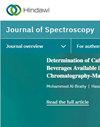利用便携式光谱和高效多变量技术快速测定土壤质量
IF 2.1
4区 化学
Q4 BIOCHEMICAL RESEARCH METHODS
引用次数: 1
摘要
快速和现场测定土壤状态和质量参数具有更大的潜力,可以改善粮食安全,并最大限度地减少过度施用土壤改良剂的浪费,从而减少环境污染。本研究采用口袋大小短波近红外光谱(740-1070 nm)和多元统计方法对加纳不同土地利用类型的土壤进行分类,并同时预测了氮(N)、磷(P)、钾(K)、钙(Ca2+)、镁(Mg2+)和pH。不同的算法。线性判别分析(LDA),支持向量机(SVM)和偏最小二乘算法(全范围偏最小二乘,FrPLS;区间偏最小二乘;尝试用协同区间偏最小二乘法(Si-PLS)来建立合适的分类和量化模型。通过预测集中的分类率、决定系数(Rp2)和预测均方根误差(RMSEP)对模型进行评价。在不同土地利用种植制度下,共采集0 ~ 15 cm、15 ~ 30 cm和30 ~ 45 cm土层土壤样品110份。结果表明,支持向量机对种植系统土壤的分类率为98.61%。Si-PLS模型对N、P、K、Mg2+、Ca2+和pH的预测效果较好。对Rp2和RMSEP分别为0.571、0.779、0.910、0.778、0.826和0.904,分别为0.033%、0.738 mg·kg−1、0.117 cmol·kg−1、0.654 cmol·kg−1、3.0219 cmol·kg−1和0.4760 pH单位,Si-PLS模型对N、P、K、Mg2+、Ca2+和pH的预测效果较好。结果表明,便携式近红外光谱技术可以用于土壤状态和一些质量参数的测量。然而,需要进一步的研究来证明它的应用。这可以提高产量,节约施肥成本。本文章由计算机程序翻译,如有差异,请以英文原文为准。
Quick Determination of Soil Quality Using Portable Spectroscopy and Efficient Multivariate Techniques
Rapid and onsite determination of the soil status and quality parameters holds a brighter potential for improving food security, and minimizing waste of the excessive application of soil amendments hence reducing environmental pollution. In this study, a pocket-sized shortwave NIR spectroscopy (740–1070 nm) and multivariate statistics were used to classify soil from different land-use types and simultaneously predict nitrogen (N), phosphorus (P), potassium (K), calcium (Ca2+), magnesium (Mg2+), and pH in Ghana. Different Algorithms. Linear discriminant analysis (LDA), support vector machine (SVM), and partial least squares algorithms (full-range partial least square, FrPLS; interval partial least squares, IPLS; synergy interval partial least squares, Si-PLS) were attempted for building a suitable classification and quantification model. The models were assessed by the classification rate, coefficient of determination (Rp2), and root mean square error of prediction (RMSEP) in the prediction set. A total of 110 soil samples from 0 to 15 cm, 15 to 30 cm, and 30 to 45 cm layers were collected from the field of different land-use cropping systems. The results obtained showed that SVM had a 98.61% classification rate of the soil from the cropping system. While Si-PLS was superior in predicting N, P, K, Mg2+, Ca2+, and pH. The performance of the Si-PLS model for N, P, K, Mg2+, Ca2+, and pH were 0.571, 0.779, 0.910, 0.778, 0.826, and 0.904 for Rp2 and 0.033%, 0.738 mg·kg−1, 0.117 cmol·kg−1, 0.654 cmol·kg−1, 3.0219 cmol·kg−1, and 0.4760 pH unit for RMSEP, respectively. The results revealed that the portable NIR spectroscopic technique could be used to measure the soil status and some quality parameters. However, further studies are needed to proof its application. This could lead to improving the yield and saving the cost of fertilizer application.
求助全文
通过发布文献求助,成功后即可免费获取论文全文。
去求助
来源期刊

Journal of Spectroscopy
BIOCHEMICAL RESEARCH METHODS-SPECTROSCOPY
CiteScore
3.00
自引率
0.00%
发文量
37
审稿时长
15 weeks
期刊介绍:
Journal of Spectroscopy (formerly titled Spectroscopy: An International Journal) is a peer-reviewed, open access journal that publishes original research articles as well as review articles in all areas of spectroscopy.
 求助内容:
求助内容: 应助结果提醒方式:
应助结果提醒方式:


